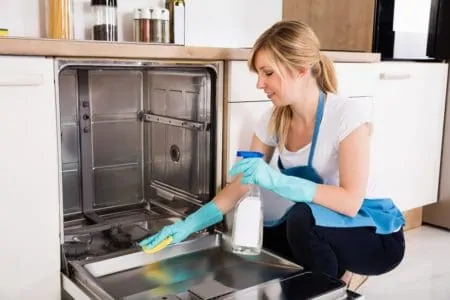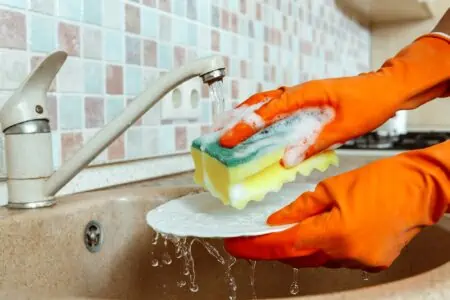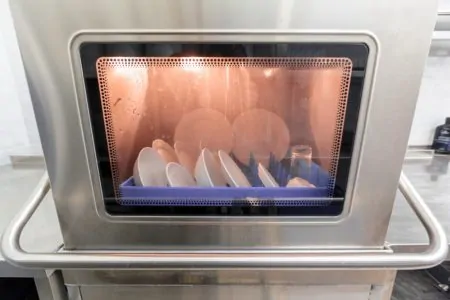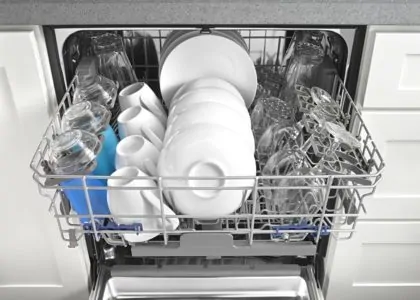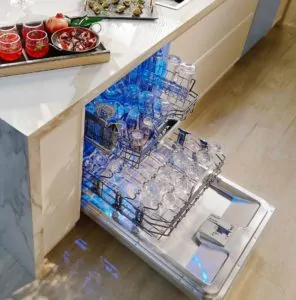Is your dishwasher smelly? Visibly dirty? Or has it just been a while since you last cleaned it?
Because your dishwasher is meant to clean all your plates, bowls, mugs and silverware — it needs to be clean itself. Dishwashers can get dirty with all the food residue, liquids, water and detergent that go around inside.
We’ll teach you how to clean your dishwasher so you can stay on top of this task. Prepare for a clean, odor-free, good-as-new dishwasher.
Key Takeaways
- Use white vinegar for a clean, odor-free dishwasher: Fill a dishwasher-safe bowl with 2-3 cups of distilled white vinegar and place it in the top rack. Run the hottest cycle possible.
- Check and clean the filter: Remove the filter, pick out any chunks of food or gunk, rinse under warm water, and scrub with a cleaning brush before placing it back into the dishwasher.
- Try baking soda for a deeper clean: Sprinkle one cup of baking soda all over the bottom of your dishwasher and run the hottest and longest cycle available.
- Clean the dishwasher drain trap: Fill up your sink with hot soapy water, remove the drain trap, and soak for one hour. Scrub with a bristle brush, rinse, and put it back in the dishwasher.
Why You Need to Clean Your Dishwasher
Your dishwasher is for washing dishes, so if it’s not clean, your dishes won’t get clean either. This appliance can get icky over time from detergent build-up and food debris. Not only can this lead to bad smells and dirt, but it can ruin the efficiency of your machine.
How to Clean Your Dishwasher With Vinegar
Cleaning your dishwasher can be inexpensive and straightforward. You don’t need fancy cleaning products. If you have vinegar in the house, that’s a great eco-friendly way to clean your dishwasher.
What You Need
- 2-3 cups of distilled white vinegar.
- Dishwasher-safe bowl.
- Spray bottle.
- Cloth.
- Cleaning brush (such as an unused toothbrush).
Step by Step Instructions
Now that you have your supplies at the ready, let’s get into it!
1. Fill a Bowl
Fill a bowl (dishwasher-safe!) with two to three cups of distilled white vinegar. Vinegar is acidic so it can break down dirt, scum and get rid of bad odors (1). Plus, it’s non-toxic so it’s safe for your whole family (and the appliance)!
2. Clean the Filter
Before you add the bowl to the dishwasher, check the filter. This is where food residue gets caught up. Remove it from its place and pick out any chunks of food or gunk. Rinse it under warm water and use a cleaning brush (such as an unused toothbrush) to clean out the nooks and crannies. Put it back into the dishwasher.
3. Place the Bowl
Place the bowl onto the upper rack of your machine. If it will only fit on the bottom, that’s fine, too. Do not put any other dishes or items into the dishwasher.
4. Run the Machine
Run the machine on the hottest setting. Hot water can help with removing grime and buildup, as well as sanitizing the machine.
5. Spray Bottle
Meanwhile, fill a spray bottle with one part vinegar and one part water. When the dishwasher cycle is finished, remove the bowl and use the spray to spritz the inside of the machine where the vinegar didn’t reach. This includes the inner frame which can get really yucky.
The vinegar in the dishwasher cycle should have been enough to clean any build-up on the dishwasher racks. But if there is still dirt and residue, use your vinegar spray and cleaning brush to scrub them clean.
You can use this vinegar spray on the outside of your dishwasher, too. Wipe the vinegar solution away with a cloth, scrubbing in more stubborn spots.
Pro Tip
How to Clean Your Dishwasher with Baking Soda
If you don’t have vinegar, baking soda is another great tool to clean your dishwasher. For a deeper clean, use both these methods, one after the other.
What You Need
- One cup of baking soda.
- Hydrogen peroxide (optional).
- Parchment paper (optional).
- All surface cleaner or vinegar spray from the method above.
- Cloth.
- Cleaning brush (or unused toothbrush).
Step by Step Instructions
Baking soda is a great natural cleaner to have in the home. How can it clean your dishwasher? Let’s dive in.
1. Clean the Filter
Remove the filter and check for food residue, build up and dirt. If it’s dirty, pick out the excess gunk.
Next, rinse the filter under warm water and with a cleaning brush (or an unused toothbrush). Scrub all the nooks and crannies until it’s sparkling clean. Rinse again. Put it back in the dishwasher.
You don’t need to clean this with soap just now because the baking soda and hot water will deep clean it.
2. Sprinkle
Sprinkle one cup of baking soda all over the bottom of your dishwasher.
If you want a deeper clean, mix together two cups of baking soda with three tablespoons of hydrogen peroxide in a bowl until you’ve created a paste. Place the paste onto parchment paper and let it dry for a few hours. Then add this to the bottom of your dishwasher.
3. Run the Cycle
Run the hottest and longest dishwasher cycle available to you. You may need to repeat this if you have really bad smells or a lot of gunk build up.
4. Spray Clean
Now, it’s time to ensure that every nook, crannies and corner is clean.
The baking soda solution should have been enough to clean the main part of your dishwasher. But check the racks and silverware caddy to ensure all dirt and grime is gone. If these bits are still dirty, use an all-purpose cleaner — or our vinegar spray recipe from above — to scrub clean.
Now, spray all the bits your baking soda solution didn’t reach. This would include the inner frame, the detergent tray and the outside of the dishwasher.
Use a dish towel to wipe the solution away. Scrub hard over stubborn spots. Voila! Your dishwasher is clean.
How to Clean Your Dishwasher with Bleach
What about bleach? Bleach might seem like an attractive choice since it’s one of the most powerful cleaners. But you shouldn’t use bleach if your dishwasher has any stainless steel parts inside. If your dishwasher is made with only plastic, then you can certainly use bleach. However, vinegar or baking soda are safer, non-toxic options.
What You Need
- ½ cup of bleach.
- Bowl.
- Cleaning brush.
- All-purpose cleaner.
- Cloth.
Step by Step Instructions
Let’s get into the best way to clean your dishwasher with bleach.
1. Check the Filter
Remove the filter and pick out any excess food residue and dirt. Rinse the filter under warm water and using a dish scrubber (or unused toothbrush), scrub out all the dirt and buildup. Rinse under warm water again, then put it back in the dishwasher.
2. Fill a Bowl and Run the Cycle
Fill a bowl (safe for the dishwasher) with ½ cup of bleach and place it on the top rack of your dishwasher. Run the machine on the hottest setting, with no other items in the machine. Bleach can kill germs, mildew and mold in your machine (2).
3. Spray Clean
Use an all-surface cleaner — or our vinegar recipe from above — and spray down all the places the bleach solution didn’t reach. This includes the inner frame, any racks that still have build-up on them, the detergent dispenser and the outside of the dishwasher. Wipe clean with a cloth, scrubbing over stubborn spots.
How to Clean Dishwasher Drain Trap
The vinegar, baking soda or bleach methods will clean your drain trap but if it’s still yucky, or you want to clean it more frequently, or in between uses, here’s how:
- Fill up your sink with hot soapy water.
- Remove the drain trap and put it in the water.
- Soak for one hour.
- Then use a bristle brush to scrub it.
- Rinse it.
- Put it back in the dishwasher.
You can definitely do this before using any of the above methods to ensure the drain trap is deeply cleaned.
Other Tips for Cleaning Dishwashers
That’s almost all there is to know about cleaning dishwashers. But we’ll leave you with a few more tips so you can be sure that your dishwasher is as clean as can be.
- Do a deep clean once a month with a dishwasher cleaner. Do a surface-level clean, with a vinegar spray or all-purpose spray, every week or so, making sure the control panel and outside of the dishwasher are nice and clean.
- Always check the drain trap to make sure there are no clogs. This is the number one culprit for your dishwasher not working as well as it should. To prevent clogs, always scrape plates before putting them in the dishwasher.
- Check your manufacturer instructions to check if there are any do’s or don’ts that we didn’t cover in this article.
- If your dishes aren’t getting cleaned, remove the spinning arm and make sure there isn’t anything stuck in the holes.
- If your dishwasher is white, use a baking soda paste to clean the exterior. This can help remove discoloration.
- Run your garbage disposal before running the dishwasher. This ensures that nothing gets backed up from the disposal into the dishwasher.
- Don’t overfill your dishwasher or it can’t do its job properly. Then you might be left with a clogged drain or more gunk coating the inside of the dishwasher.
FAQs
Dirty It Up Again
Now that your dishwasher is nice and clean, time to fill it back up with dirty dishes! It may seem like a pointless thing to do but it can help extend the lifespan of your machine. Plus, it will deliver the best results when cleaning a day’s worth of dishes.
We’re sure that in a few weeks, when you need to do this again, you’ll be fully equipped.
